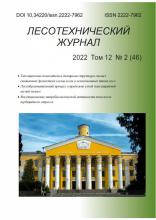Russian Federation
Sankt-Peterburg, St. Petersburg, Russian Federation
Sankt-Peterburg, St. Petersburg, Russian Federation
Abstract The subject of the proposed study is aimed at studying the process of grinding barking waste. The main tasks of experimental research are to establish general patterns linking the energy intensity of grinding of debarking waste with the degree of grinding and to estimate the energy intensity of the grinding operation of barking waste in prepara-tion for utilization. The article presents the results of experiments on crushing waste from spruce and pine, performed with the Erdwich M600 / 1-400 industrial choppers. For each of the two species, 9 groups of experimental material have been examined at different humidity and degree of grinding. It is shown that the specific energy intensity of grinding waste from spruce and pine barking is associated with the relative humidity of the barking waste and the degree of their grinding by a nonlinear dependence repeating the structure of the Kirpichev-Kick grinding law; corresponding mathematical models are got. It has been established that the ratio of heat combustion of the dry matter contained in the bark crushing product ("energy cost") and the energy expended for its crushing ("energy prime cost") depends on the relative humidity of the bark, and the dependence has a minimum point. The optimum moisture content of the waste products from the spruce, subject to grinding, is 25%, pine - 27%. It is established that the specific energy intensity of grinding waste from debarking spruce and pine with the optimum humidity is proportional to the natural logarithm of the degree of grinding. With optimum humidity for grinding waste, debarking sprues in 5-15 times requires energy consumption of 5-10% of the calorific value. At optimum humidity for pine waste grinding in 5-15 times, energy making 7-14% of a heat of combustion is required
grinding, energy intensity, barking waste, knife working body
1. Andreev S.E., Perov V.A., Zverevich V.V. Droblenie, izmel'chenie i grohochenie poleznyh iskopaemyh [Crush-ing, grinding and screening of minerals] // M.: Nedra, 1980. 416 p.
2. Bastrikov D.V., Vlasov Ju.N., Kucher S.V., Kunickaja D.E. Jeksperimental'nye issledovanija jenergoemkosti droblenija othodov okorki eli [Experimental studies of the energy consumption of waste from spruce debarking shredding] // Izvestija Sankt-Peterburgskoj lesotehnicheskoj akademii [Proceedings of Saint-Petersburg Forestry Academy]. 2016. #217. S. 81-90 pp. DOI: https://doi.org/10.21266/2079-4304.2016.217.81-90; EDN: https://elibrary.ru/XHUMYX
3. Bastrikov D.V., Vlasov Ju.N., Chibirev O.V. Rezul'taty predvaritel'nyh jeksperimentov po drobleniju kory sosny [Results of preliminary experiments on pine bark shredding] // Aktual'nye napravlenija nauchnyh issledovanij XXI veka: teorija i praktika [Actual directions of scientific research of the XXI century: theory and practice]. 2016. Vol. 4. No. 1 (21). Pp. 63-66. DOI: https://doi.org/10.12737/19258; EDN: https://elibrary.ru/VUZNKP
4. Bastrikov D.V., Kacadze V.A. Model' izmenenija frakcionnogo sostava kory v hode izmel'chenija [Model of the change in the fractional composition of bark during shredding] // Aktual'nye napravlenija nauchnyh issledovanij XXI veka: teorija i praktika [Actual directions of scientific research of the XXI century: theory and practice]. 2015. Vol. 3. No. 2-2 (13-2). Pp. 170-173.
5. Grigor'ev I.V., Hitrov E.G., Nikiforova A.I., Grigor'eva O.I., Kunickaya O.A. Opredelenie ehnergoemkosti produktov lesopol'zovaniya v ramkah metodiki ocenki ehkologicheskoj ehffektivnosti lesopol'zovaniya [Evaluation of energy consumption of forestry products in the framework of the methodology for assessing the ecological efficiency of forest management] // Vestnik Tambovskogo universiteta [Herald of Tambov State University]. 2014. #5. 1499-1502 pp. EDN: https://elibrary.ru/SMOBCR
6. Kunickaya O.A., Hitrov E.G., Il'yushenko D.A. Uplotnenie drevesnyh materialov pod dejstviem udarnoj nagruzki [Briquetting of wood materials under the impact of dynamic loading] // Nauchnoe obozrenie [Scien-tific Review]. 2012. #4. 121-127 pp. EDN: https://elibrary.ru/PJBRHP
7. Grigorev I., Khitrov E., Kalistratov A., Bozhbov V., Ivanov V. New approach for forest production stocktaking based on energy cost // International Multidisciplinary Scientific GeoConference Surveying Geology and Min-ing Ecology Management, SGEM 14. 2014. 407-414 pp. DOI: https://doi.org/10.5593/SGEM2014/B32/S14.055; EDN: https://elibrary.ru/XVNZHO
8. Grigorev I., Nikiforova A., Khitrov E., Ivanov V., Gasparian G. Softwood harvesting and processing problem in Russian Federation // International Multidisciplinary Scientific GeoConference Surveying Geology and Mining Ecology Management, SGEM 14. 2014. 443-446 pp. DOI: https://doi.org/10.5593/SGEM2014/B32/S14.059; EDN: https://elibrary.ru/ROQIME
9. Jenkins, B., Baxter, L., Miles, T. & Miles, J. (1998). Combustion properties of biomass. Fuel Process Technol, 54, 17-46.
10. Jenkins B.M., Properties of biomass, Biomass Energy Fundamentals, EPRI TR-102107, Electric Power Re-search Institute, Palo Alto, CA, 1993.
11. Jenkins B.M., Physical properties of biomass, in: O. Kitani, C.W. Hall Eds. , Biomass Handbook, Chap. Ž . 5.2, Gordon & Breach, New York, NY, 1989.
12. Sikkema, K., Steiner, M., Junginger, M., Hiegl, W., Hansen, M. & Faaij, A. (2013). The European wood pellet markets: current status and prospects for 2020. Biofuels, Bioproducts and Biorefining, 5, 250-278












